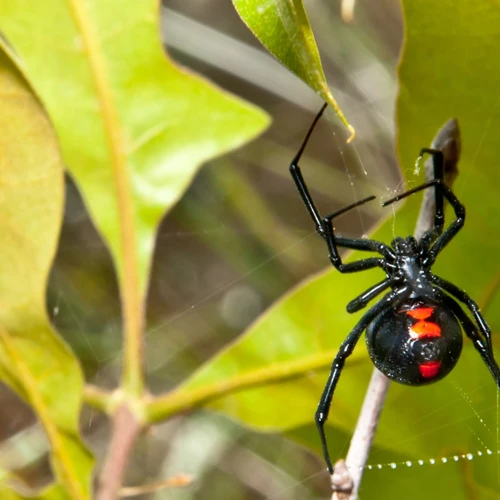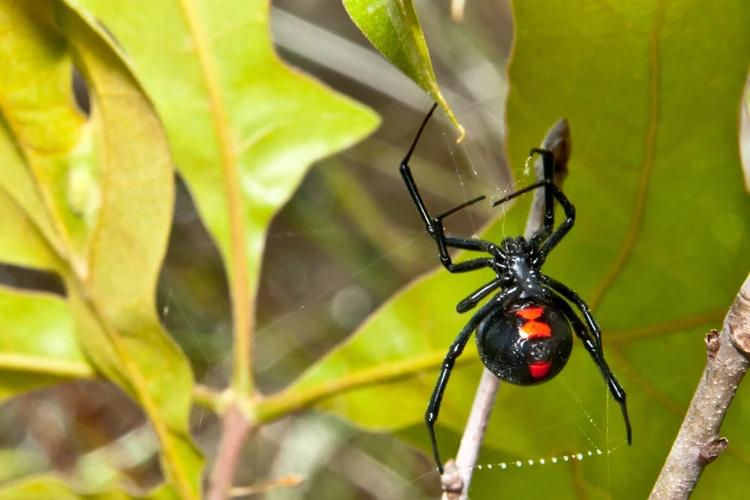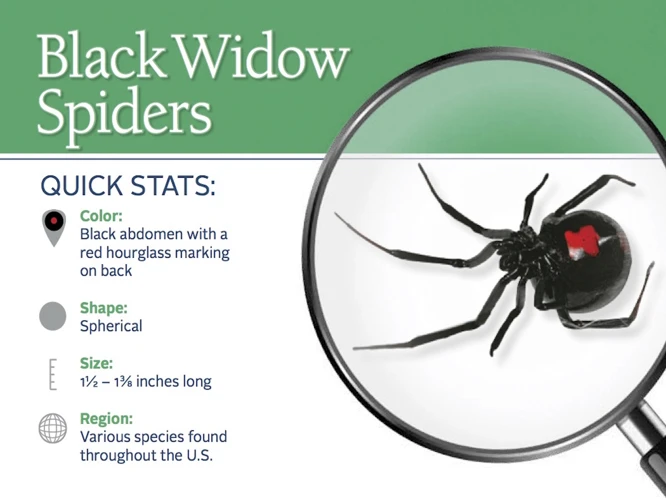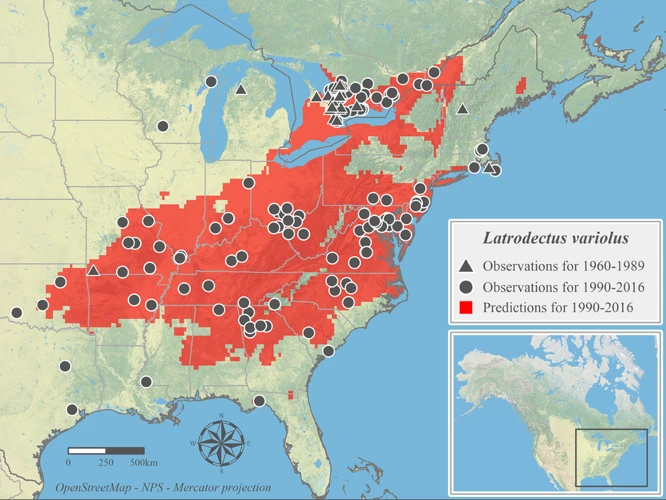As we explore the habitats of black widow spiders across the United States, it is important to first understand what makes these spiders so unique and intriguing. Black widow spiders, known for their venomous bites, are widely recognized for their distinctive appearance with a shiny black body and a red hourglass shape on their underside. But these spiders can also be found in a range of environments, from the great outdoors to the comfort of our own homes. In this article, we will dive into the various habitats of black widow spiders and provide tips for preventing infestations and safely removing them if necessary. So, buckle up and let’s explore the world of black widow spiders together.
What Are Black Widow Spiders?

Uncovering the Details of Black Widow Spiders
Before taking any measures to prevent an infestation of black widow spiders in your home or yard, it’s essential to understand what they are. These venomous arachnids have distinctive characteristics that set them apart from other spiders. Typically, female black widow spiders have glossy black bodies with a characteristic reddish-orange hourglass shape on their underside. They prefer to build their webs in dark, secluded areas, so it’s often difficult to notice them until an infestation occurs. Understanding their habits and habitat is also crucial in eliminating and preventing them from invading your personal space. If you’re looking to identify potential black widow habitats, consider checking out identifying black widow habitats in your home article for further insight.
Identification
Black Widow Spiders are one of the most venomous spiders found in North America. It’s essential to be able to identify them properly. Here are some key characteristics that will help identify a Black Widow Spider:
- Size: Female Black Widow Spiders are the larger of the two sexes, measuring about 1.5 inches including their legs, while the males measure only about half that size.
- Color: Black Widow Spiders are known for their shiny jet-black bodies that feature a distinct red hourglass-shaped marking on their underside.
- Web: They often build their irregular webs in dark, undisturbed areas such as garages, basements, closets, and crawl spaces.
It is important to note that juvenile Black Widow Spiders have a different appearance than mature adults. Young Black Widow Spiders are typically tan or light brown, and have white or yellow stripes running across their backs. Their color changes to black as they mature.
It is important to know how to identify Black Widow spiders as their bites can be quite painful and are potentially dangerous, especially for young children or those with weakened immune systems. If you are worried that you may have Black Widow Spiders on your property, check out our guide on checking Black Widow habitats. Additionally, taking measures to create an unappealing habitat for black widows such as reducing clutter and sealing gaps in windows and doors can help prevent infestations.
Black Widow Spider Habitats

Understanding the Habitat of Black Widow Spiders
Black widow spiders, scientifically known as Latrodectus, are venomous spiders that can be found in various habitats across the United States. These spiders are notorious for their distinctive appearance, with glossy black bodies and a bright red hourglass-shaped marking on their abdomen. However, despite their striking appearance and notoriety, the habitat of black widow spiders can vary widely depending on a number of factors. Some of these factors include habitat destruction and climate change, both of which can affect the spider’s preferred habitats. In this article, we’ll explore the different habitats where black widow spiders can be found, both indoors and outdoors, and the steps you can take to prevent infestations. Additionally, we’ll provide guidance on what to do if you find a black widow spider in or around your home. Keep reading for more information on these venomous spiders and their preferred habitats. If you’re interested in learning more about the impact of human activity on black widow spider habitats or the spider’s habitat preferences, check out our articles on habitat destruction and climate change and spider habitat preferences.
Outdoor Habitats
Black widow spiders prefer warm environments, which makes them more prevalent in the southern United States, but they can also be found in many other areas across the country. When it comes to outdoor habitats, black widow spiders are commonly found in areas where they can easily create nests and find food sources.
One common outdoor habitat for black widow spiders is in piles of organic material such as wood, leaves, and other debris that have accumulated over time. These piles create a perfect hiding place for black widow spiders as they can easily spin their webs and become inconspicuous. It is important to always be cautious when moving piles of wood or debris as this can disturb black widow spiders and cause them to feel threatened.
Another common outdoor habitat for black widow spiders is in gardens and landscaping areas. These areas provide ample hiding places such as dense foliage and heavy plants. It is important to keep gardens and landscaping areas well-maintained and trimmed to prevent black widow spider infestations. Any gaps or holes in fencing or walls should be sealed to prevent black widow spiders from entering the property.
Black widow spiders also thrive in dark and damp environments such as basements, crawl spaces, and garages. These areas often contain a lot of clutter and debris, which provide the ideal nesting spots for black widow spiders. To avoid black widow spider infestations in outdoor environments, it’s important to keep these areas clean and well-lit. Repairing any leaks or other issues that can cause dampness is also a good idea.
Table of common black widow spider outdoor habitats:
| Habitat | Description |
| — | — |
| Piles of wood and debris | Organic materials that make a great hiding place for black widow spiders |
| Gardens and landscaping areas | Dense foliage and heavy plants provide hiding places for black widow spiders |
| Dark and damp environments | Basements, crawl spaces, and garages that contain clutter and debris provide ideal nesting spots for black widow spiders |
If you are interested in learning more about how human activities impact black widow spider habitats, you can check out our article on human impact on black widow spider habitats.
Indoor Habitats
Indoor habitats are a prime location for black widow spider infestations, as these spiders prefer dark and undisturbed areas to build their webs. One common indoor habitat for black widow spiders is cluttered spaces, such as attics, basements, and storage rooms. They also like to hide in the gaps and crevices in walls and ceilings. Thus, it’s important to keep these areas clean and clutter-free, making it harder for the spiders to build their webs.
It’s also essential to inspect any clothing or shoes before using them, especially if they have been sitting in storage for a prolonged time. Black widows love to hide in these items and can crawl out unexpectedly, causing a dangerous situation for humans. Always shake out shoes and clothes before putting them on or wearing them.
Another indoor habitat for black widow spiders is cardboard boxes, which are prevalent in storage areas. These boxes provide a perfect environment for these pests to hide and reproduce. Instead of using cardboard boxes, consider using plastic containers with tight lids. It will not only protect your belongings but also eliminate black widow spider habitats.
It’s vital to eliminate any potential hiding spots and entry points for black widow spiders. Cracks, crevices, and gaps in a building’s foundation, walls, or roof can give black widow spiders easy access to your home. To prevent this, use weather-stripping to seal doors and windows, and install screens on windows and ventilation openings.
In case of a potential black widow spider infestation, it’s crucial to contact a professional pest control service immediately. Attempting to remove black widow spiders on your own can be dangerous, especially if you’re not familiar with their habits and behaviors. Professional pest control services have the knowledge and equipment to remove black widow spiders safely and effectively.
To learn more about how to check for black widow spiders during house hunting, click here.
Thus, it’s essential to keep your indoor space clean, eliminate any possible hiding spots, and seek professional help if necessary to ensure that black widow spiders do not build their habitats in your home. Don’t let these dangerous pests threaten your safety and well-being. For more information on what attracts black widow spiders to habitats, you can check out this link and tips on how to eliminate black widow spider habitats here.
Commonly Infested Areas
Black widow spiders are known to thrive in a variety of environments, ranging from outdoor spaces to indoor areas. Some of the most commonly infested areas include:
| Location | Type of Environment | Reason for Infestation |
|---|---|---|
| Garages | Indoor | The clutter found in most garages provides ample opportunities for black widow spiders to hide, nest, and lay eggs. |
| Sheds | Outdoor | The dark and secluded environment of a shed provides black widow spiders with the perfect place to spin webs and lay eggs undisturbed. |
| Basements | Indoor | Basements are often damp and dark, making them a prime spot for black widow spiders to hide and build webs. |
| Attics | Indoor | The warm and humid environment found in many attics makes them a cozy spot for black widow spiders to thrive. |
| Outdoor Structures | Outdoor | Black widow spiders are known to build their webs under decks, on fences, and in other outdoor structures where they can remain hidden and undisturbed. |
| Outdoor Play Areas | Outdoor | Children’s play equipment, such as swings, slides, and climbing structures, can provide black widow spiders with a convenient place to spin their webs and hunt for food. |
It is important to note that these are not the only areas where black widow spiders can be found. They have been known to infest many other locations, including abandoned buildings, piles of firewood, and even shoes and clothing left outside.
If you suspect that your property may be infested with black widow spiders, it is essential that you take immediate action to prevent the spiders from spreading. Consider contacting a professional pest control service for assistance, and take steps to seal up any entry points that spiders may be using to gain access to your property.
Preventing Black Widow Spider Infestations

You don’t want to find yourself face-to-face with a black widow spider, so preventing infestations is crucial. By taking preventative measures, you can reduce your risk of encountering these venomous arachnids. But where do you start? Luckily, there are several steps you can take to keep your property spider-free. Keep reading to learn how to reduce your chances of a black widow spider infestation.
Keeping Your Property Clean
One effective way to prevent black widow spider infestations in and around your property is by keeping it clean. Here are some tips to help you keep your property clean and spider-free:
- Regular Cleaning – Keeping your home or business clean and clutter-free is essential to preventing spider infestations. Regularly dust and vacuum corners, ceilings, and other areas where spiders may spin webs.
- Elimination of Clutter – Remove stacks of cardboard boxes, piles of clothing, and other clutter that can provide a hiding spot for spiders. Make sure to declutter storage and basement areas as well.
- Outdoor Maintenance – Keep the exterior of your property clean as well. Rake up leaves and debris, trim bushes and trees, and remove any piles of wood, rocks, or other natural debris where spiders could hide or nest.
- Food Storage – Make sure to store your food in airtight containers, as black widow spiders are attracted to food sources. Spot check regularly for any potential openings and keep any and all opened food sealed up tightly.
- Pest Control – Finally, consider using pest control measures to eliminate any existing insect or arachnid infestations that could be attracting black widow spiders.
By following these tips and keeping your property clean and well-maintained, you can greatly reduce the likelihood of a black widow spider infestation.
Sealing Up Entry Points
Sealing up entry points is a crucial step in preventing black widow spider infestations in your home. These spiders can enter through small gaps and cracks in windows, doors, and walls, so it’s important to make sure these areas are properly sealed. Here are some key areas of your home to focus on when sealing up entry points:
| Location | Possible Entry Points | Prevention Tips |
|---|---|---|
| Doors | Space under the door, gaps around the door frame | Install weather stripping along the bottom of the door and around the frame, use door sweeps |
| Windows | Cracks in window frames, gaps around the window frame | Use caulk to seal any cracks or gaps, install screens on windows |
| Walls | Small holes or cracks in walls | Use spackle or caulk to fill in any holes or cracks in walls |
| Vents and ducts | Gaps around vents or ducts | Use caulk or foam insulation to seal any gaps around vents and ducts |
Remember to pay particular attention to areas where utilities enter your home, such as electrical outlets, cable lines, and plumbing pipes. These could be potential entry points for black widow spiders as well.
Properly sealing up these entry points can go a long way in keeping black widow spiders out of your home and preventing infestations. Once you have sealed up these entry points, it’s important to regularly inspect them to make sure there are no new gaps or openings that could allow spiders to enter. By taking these necessary precautions, you can help protect your home and family from these potentially dangerous spiders.
Eliminating Food Sources
In order to prevent black widow spiders from infesting your home, it’s important to eliminate their food sources. These spiders primarily feed on insects, especially other small spiders and roaches. Here are some ways to make your home less attractive to their prey:
| Eliminating Food Sources |
|---|
| Clean up crumbs and spills promptly. Small insects are attracted to leftover food, which in turn attracts black widow prey. |
| Reduce clutter and keep your home well-organized. Dark, cluttered areas provide hiding places for insects, which are a prime food source for black widows. |
| Fix any leaks or standing water sources in and around your home. Standing water can attract mosquitoes, which in turn are a food source for black widow prey. |
| Seal up any holes or gaps in your home. Insects can easily find their way into homes through small holes and crevices, so closing them up can help reduce their prey population. |
| Keep your outdoor areas, such as trash cans and compost piles, far away from your home. These areas can attract insects which in turn attract black widow prey. |
By eliminating black widow spider prey, you are reducing the likelihood of them entering your home in search of food. It’s important to regularly check and maintain these measures to ensure that black widow spiders don’t find their way into your home.
Professional Pest Control
Professional pest control is a reliable solution to get rid of black widow spiders. These spider infestations can be difficult to tackle on your own, especially if you have a severe infestation. Hiring a licensed and experienced exterminator can ensure that the infestation is completely eliminated, and necessary precautions are taken to prevent any future incidents.
Here are some of the advantages of professional pest control for black widow spiders:
| Advantages of Professional Pest Control |
|---|
| 1. Identification: Professional pest control technicians can easily identify black widow spiders and their habitats. |
| 2. Effective Treatments: They use advanced and effective treatments to eliminate black widow spiders from your property. |
| 3. Safe Removal: They have the necessary tools and techniques to safely remove the spiders without causing harm to humans or pets. |
| 4. Prevention: Pest control professionals provide advice on how to prevent future infestations from occurring. |
| 5. Warranty: Most pest control companies offer warranties to guarantee their services, which gives peace of mind to homeowners. |
It’s important to note that professional pest control can be more expensive than DIY methods, but it’s worth it in the long run. It’s an investment in the safety and comfort of your home. Don’t forget to do your research and choose a licensed and reputable pest control company before booking their services.
What to Do If You Find a Black Widow Spider
Encountering a black widow spider can be a terrifying experience for anyone, especially considering their venomous bites can have severe consequences. Yet, it’s not uncommon to stumble upon one of these spiders in your home or yard. In such situations, it’s important to know what steps you can take to protect yourself and others. This section of the article will provide you with practical advice on handling a black widow spider sighting and what to do if you or someone else gets bitten. So, stay alert, be cautious, and remember these tips to avoid any unwanted encounters with this dangerous spider.
Safely Removing Them
When it comes to removing a black widow spider, it’s important to take precautions to avoid getting bitten. Here are some safe methods for removing them:
| Method | Description |
|---|---|
| Using gloves | Wearing gloves can help protect your hands while handling a black widow spider. Carefully place a container over the spider, then slide a piece of paper or cardboard underneath. Gently lift the container and take it outdoors to release the spider. |
| Vacuuming | Using a vacuum with a hose attachment can also be an effective way to remove a black widow spider. Make sure to use a vacuum with a strong suction and keep a safe distance from the spider while vacuuming it up. Afterward, dispose of the vacuum bag outside of your home. |
| Professional help | If you’re uncomfortable handling a black widow spider, or if you’ve found a large infestation, it’s best to call a professional pest control company to safely remove them for you. |
It’s important not to attempt to handle a black widow spider with your bare hands, as their bite can be very dangerous. Stay calm and take the necessary precautions to safely remove the spider without putting yourself or others in harm’s way.
When to Seek Medical Attention
Black widow spiders are venomous, which means their bites can be dangerous. While not all bites require medical attention, it’s important to know when to seek help. Here are some signs that you should see a doctor:
- If you begin to experience intense pain, cramping, or spasms in the bitten area, seek medical attention immediately.
- If you notice any swelling or redness that spreads beyond the bitten area, seek medical attention as soon as possible.
- Severe abdominal pain and muscle cramps can indicate that the venom has spread to other parts of the body. Seek medical attention right away if you experience these symptoms.
- If you have trouble breathing or experience chest pain after a black widow spider bite, seek emergency medical attention immediately.
Remember, it’s always better to err on the side of caution when it comes to venomous spider bites. Even if you’re not sure if the symptoms warrant a doctor visit, it’s always a good idea to call a medical professional for advice. If you do need to seek medical attention, try to provide as much information as possible about the spider that bit you and the symptoms you’re experiencing. This can help the medical team determine the best course of action for your particular situation.
Conclusion
In conclusion, black widow spiders are a dangerous and often feared household pest. They are easily identified by their distinctive appearance, with the females’ shiny black bodies and red hourglass-shaped markings. These spiders can be found in a variety of outdoor and indoor habitats across the United States, including wood piles, gardens, attics, and basements.
It is important to take preventative measures to reduce the risk of infestation, such as keeping your property clean, sealing up entry points, and eliminating sources of food. In the case that you do find a black widow spider, it is crucial to safely remove it and, in some cases, seek medical attention if bitten. It is recommended to call in a professional pest control company for assistance with a severe infestation.
Overall, black widow spider control is essential for the health and safety of your home. With proper prevention and response, you can reduce the risk of encountering this venomous arachnid and maintain a peaceful living environment. Remember to always exercise caution and stay informed about potential pest threats in your area.
Frequently Asked Questions
What is the habitat of the black widow spider?
Black widow spiders can be found throughout most of the United States, but they prefer warm locations with high humidity, such as garages, basements, sheds, and piles of debris.
What do black widow spiders look like?
Black widow spiders are usually shiny black with a red or orange hourglass shape on their abdomen. Females are larger than males, growing up to an inch in length, while males only reach about half that size.
Are black widow spider bites deadly?
While black widow spider bites can be painful, they are rarely deadly to healthy adults. However, young children, the elderly, and those with weakened immune systems may be at a higher risk of complications.
What should I do if I find a black widow spider in my home?
If you find a black widow spider in your home, it’s best to call a professional pest control service to remove it safely. Attempting to remove the spider on your own can be dangerous.
How can I prevent black widow spiders from infesting my home?
Keeping your property clean and clutter-free, sealing up entry points, eliminating food sources, and hiring a professional pest control service are all effective ways to prevent black widow spider infestations.
Do black widow spiders only live in dark areas?
While black widow spiders do prefer dark areas, they can also be found in bright, well-lit areas such as outside under eaves or table umbrellas.
Can black widow spiders be found in urban areas?
Yes, black widow spiders can be found in urban areas, especially in places with high humidity like basements, garages, and sheds.
What are the dangers of a black widow spider bite?
The venom of a black widow spider can cause muscle aches, spasms, abdominal pain, and difficulty breathing. In severe cases, it can even result in death, although this is rare.
How do I know if I’ve been bitten by a black widow spider?
Black widow spider bites typically cause a sharp pain in the area of the bite, along with muscle cramps, spasms, and general discomfort. If you think you may have been bitten, seek medical attention right away.
What is the best way to keep black widow spiders out of my home?
The best way to keep black widow spiders out of your home is to keep it clean and free of clutter, seal up any potential entry points, eliminate food sources, and hire a professional pest control service to regularly inspect and treat your property.






